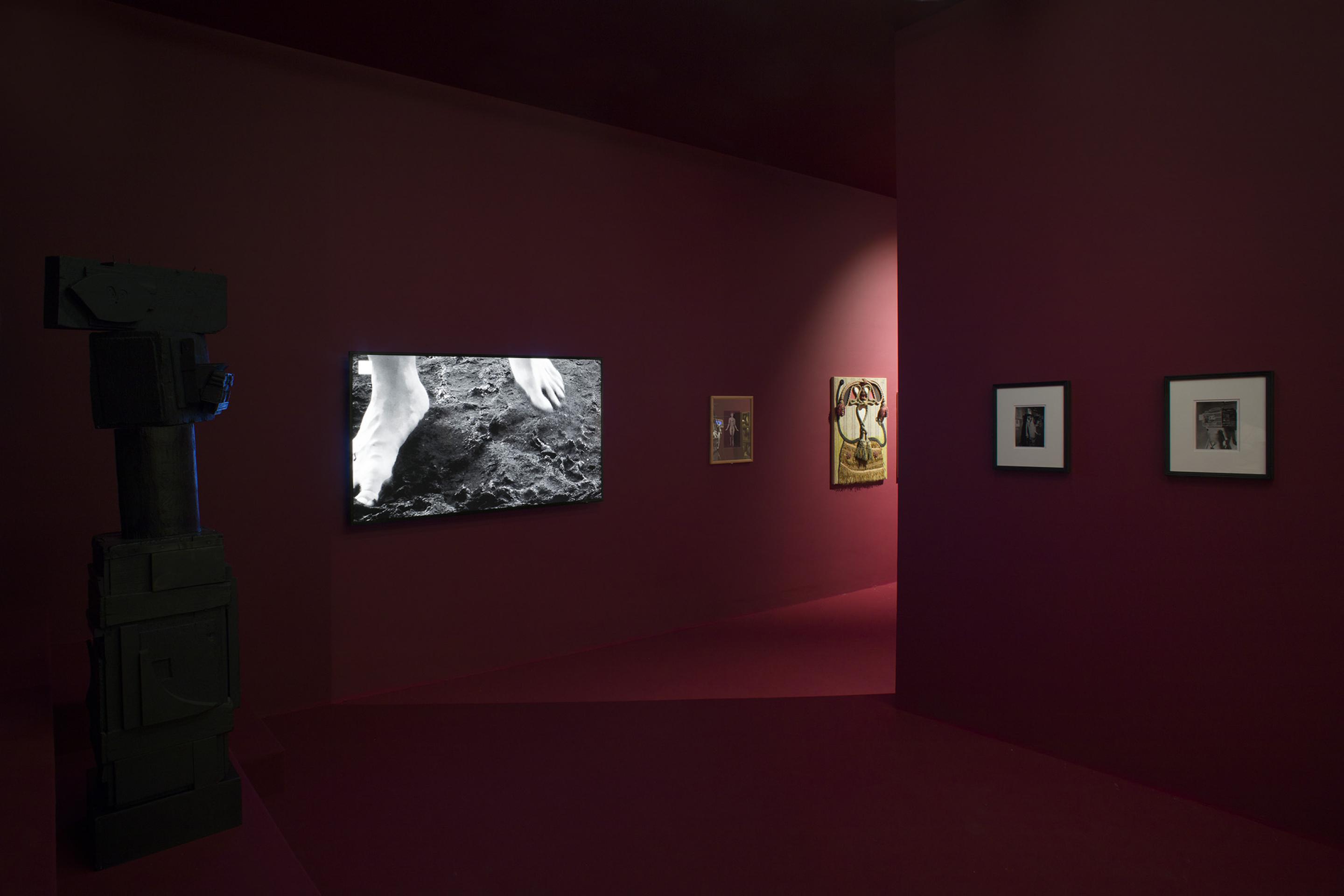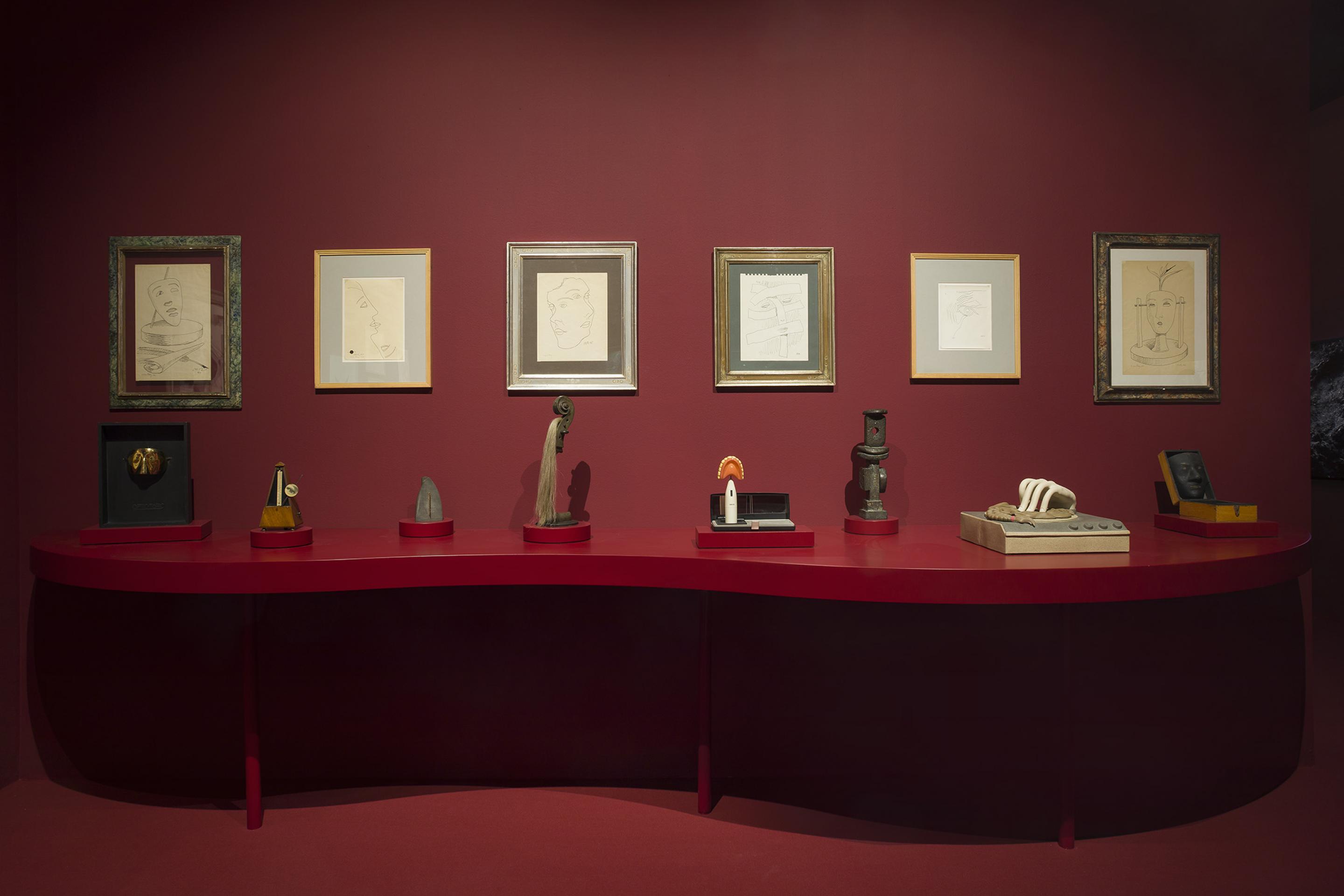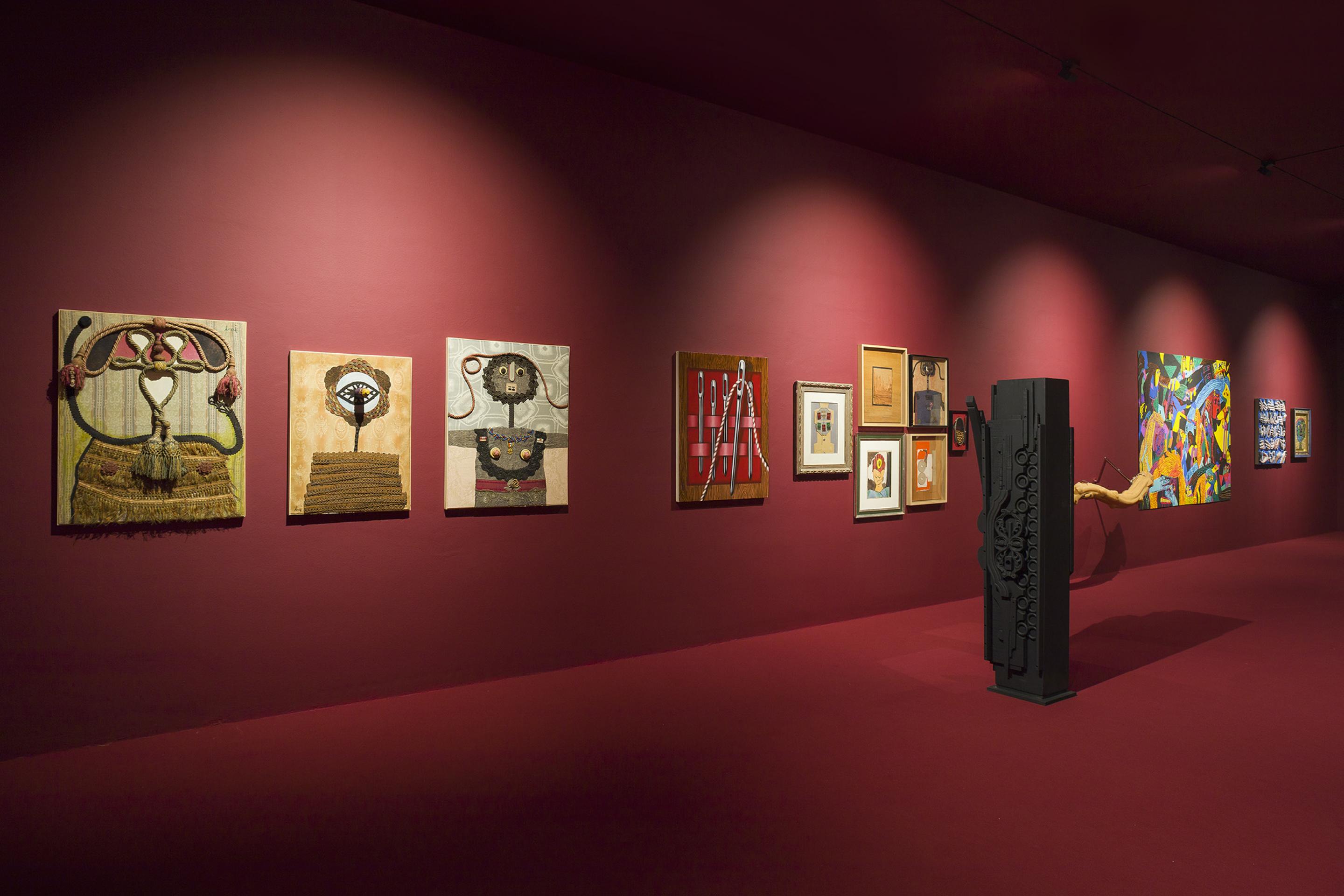GroupSHOW
I campi magnetici
Gió Marconi, Milan
04.05.–19.07.2019
I campi magnetici
Gió Marconi, Milan
04.05.–19.07.2019
IT
I campi magnetici
Enrico Baj, Gina Beavers, Genesis Belanger, Kerstin Brätsch, Elaine Cameron-Weir, Santiago De Paoli, Richard Hamilton, Hannah Levy, Louise Nevelson, Virginia Overton, Julia Phillips, Man Ray, Emily Mae Smith, Summer Wheat
A cura di Cecilia Alemani
Inaugurazione: sabato 4 maggio 2019 dalle 12 alle 19
4 maggio - 19 luglio 2019
martedì - sabato; 11-19
Nel 1919 André Breton e Paul Soupault conducono uno dei primi leggendari esperimenti di scrittura automatica: per intere giornate e notti insonni Breton e Soupault scrivono testi a quattro mani, seguendo libere associazioni e spericolati accostamenti verbali, cercando di svincolarsi dal controllo della ragione. Questi pensieri in libertà vengono raccolti nella pubblicazione I campi magnetici, apparsa nel 1920, qualche anno prima della nascita ufficiale del surrealismo consacrata dal manifesto del 1924. I campi magnetici può essere considerata la prima opera letteraria basata sulla scrittura automatica: raccoglie infatti un flusso ininterrotto di testi intrisi di immagini che sgorgano dall’inconscio – sogni, allucinazioni e desideri profondi, lontani dalla logica utilitaristica del linguaggio comune, a favore invece di una narrazione ricca e generativa di nuovi legami con la realtà.
A cent’anni di distanza, la mostra I campi magnetici prende spunto da questo essenziale testo surrealista per intessere un dialogo tra diverse generazioni di artisti che usano la rappresentazione del corpo e delle sue metamorfosi come veicoli per riflettere su tematiche quali l’identità e il desiderio.
Mettendo a confronto le opere di artisti storici come Man Ray con quelle di vari eredi della sensibilità surrealista quali Enrico Baj, Richard Hamilton e Louise Nevelson, la mostra I campi magnetici introduce anche il lavoro di vari giovani artisti che praticano una forma di neo-surrealismo, mescolando un rinnovato interesse per la figurazione con tensioni più oscure o, alternativamente, con un senso solare di meraviglia e stupore.
Attraverso un fitto dialogo inter-generazionale, la mostra registra le forze di attrazione e repulsione che intrecciano a distanza le opere di vari artisti contemporanei e moderni, collegando maestri del ventesimo secolo e giovani promesse dell’arte internazionale. La mostra funge così anche da biografia intellettuale della Galleria Marconi, innestando sull’eredità storica dello Studio Marconi l’instancabile ricerca di nuovi talenti di Gió Marconi.
Curata da Cecilia Alemani, la mostra si focalizza sulla rappresentazione del corpo – e, in particolare, del corpo femminile – per analizzare e contrastare diverse concezioni della sessualità e della definizione del sé. Tra feticci e totem, la mostra I campi magnetici mette in scena molteplici anatomie fantastiche, in cui il corpo è rappresentato in un flusso costante di trasformazione: dispossessato, dematerializzato, e ricomposto. Installata come una camera delle meraviglie – o una “camera nera”, per citare una delle oltre 20 importanti opere di Man Ray in mostra – I campi magnetici alterna volti e ritratti, oggetti antropomorfi e corpi senz’organi, talismani e fantocci mutanti.
La mostra si apre con un’infilata di fotografie nelle quali Man Ray ha ritratto i manichini che adornavano l’ingresso dell’Esposizione Internazionale del Surrealismo del 1938 a Parigi. Una serie di opere di Louise Nevelson, Man Ray, Virginia Overton e Julia Phillips riprende e amplifica le atmosfere perturbanti del surrealismo, combinando oggetti quotidiani e misteriose rivelazioni metafisiche.
Nella sala principale, trasformata in un boudoir, si susseguono opere storiche e nuove scoperte, in un piccolo psicodramma da camera nel quale i diagrammi interiori di Kerstin Brätsch convivono accanto alle dame di bric-a-brac di Enrico Baj o vicino alle stele della Nevelson. Le più giovani Hannah Levy, Elaine Cameron-Weir e Julia Phillips, invece, compongono protesi per nuovi corpi post-umani e altre divinità ortopediche – parenti lontani delle marionette di inizio secolo e degli strumenti medici che tanto hanno affascinato sia Man Ray sia Richard Hamilton. I quadri di Gina Beavers, Santiago De Paoli, Emily Mae Smith e Summer Wheat riprendono linguaggi vernacolari, tra il pop e il naïf, con i quali descrivono frammenti di anatomie pulsanti di desideri, mentre le sculture morbide di Genesis Belanger aggiornano gli oggetti d’affezione di Man Ray in un gioco di rimandi continui tra passato e futuro, sotto l’influenza di nuove forme di attrazione tra opposti.
I campi magnetici è la seconda mostra curata da Cecilia Alemani per la Galleria Gió Marconi. Nel 2009 la mostra Solaris aveva introdotto per la prima volta al pubblico milanese le opere di Rosa Barba, Kerstin Brätsch, Haris Epaminonda, David Maljković, e i video e le sculture di Ryan Trecartin e Lizzie Fitch.
Enrico Baj, Gina Beavers, Genesis Belanger, Kerstin Brätsch, Elaine Cameron-Weir, Santiago De Paoli, Richard Hamilton, Hannah Levy, Louise Nevelson, Virginia Overton, Julia Phillips, Man Ray, Emily Mae Smith, Summer Wheat
A cura di Cecilia Alemani
Inaugurazione: sabato 4 maggio 2019 dalle 12 alle 19
4 maggio - 19 luglio 2019
martedì - sabato; 11-19
Nel 1919 André Breton e Paul Soupault conducono uno dei primi leggendari esperimenti di scrittura automatica: per intere giornate e notti insonni Breton e Soupault scrivono testi a quattro mani, seguendo libere associazioni e spericolati accostamenti verbali, cercando di svincolarsi dal controllo della ragione. Questi pensieri in libertà vengono raccolti nella pubblicazione I campi magnetici, apparsa nel 1920, qualche anno prima della nascita ufficiale del surrealismo consacrata dal manifesto del 1924. I campi magnetici può essere considerata la prima opera letteraria basata sulla scrittura automatica: raccoglie infatti un flusso ininterrotto di testi intrisi di immagini che sgorgano dall’inconscio – sogni, allucinazioni e desideri profondi, lontani dalla logica utilitaristica del linguaggio comune, a favore invece di una narrazione ricca e generativa di nuovi legami con la realtà.
A cent’anni di distanza, la mostra I campi magnetici prende spunto da questo essenziale testo surrealista per intessere un dialogo tra diverse generazioni di artisti che usano la rappresentazione del corpo e delle sue metamorfosi come veicoli per riflettere su tematiche quali l’identità e il desiderio.
Mettendo a confronto le opere di artisti storici come Man Ray con quelle di vari eredi della sensibilità surrealista quali Enrico Baj, Richard Hamilton e Louise Nevelson, la mostra I campi magnetici introduce anche il lavoro di vari giovani artisti che praticano una forma di neo-surrealismo, mescolando un rinnovato interesse per la figurazione con tensioni più oscure o, alternativamente, con un senso solare di meraviglia e stupore.
Attraverso un fitto dialogo inter-generazionale, la mostra registra le forze di attrazione e repulsione che intrecciano a distanza le opere di vari artisti contemporanei e moderni, collegando maestri del ventesimo secolo e giovani promesse dell’arte internazionale. La mostra funge così anche da biografia intellettuale della Galleria Marconi, innestando sull’eredità storica dello Studio Marconi l’instancabile ricerca di nuovi talenti di Gió Marconi.
Curata da Cecilia Alemani, la mostra si focalizza sulla rappresentazione del corpo – e, in particolare, del corpo femminile – per analizzare e contrastare diverse concezioni della sessualità e della definizione del sé. Tra feticci e totem, la mostra I campi magnetici mette in scena molteplici anatomie fantastiche, in cui il corpo è rappresentato in un flusso costante di trasformazione: dispossessato, dematerializzato, e ricomposto. Installata come una camera delle meraviglie – o una “camera nera”, per citare una delle oltre 20 importanti opere di Man Ray in mostra – I campi magnetici alterna volti e ritratti, oggetti antropomorfi e corpi senz’organi, talismani e fantocci mutanti.
La mostra si apre con un’infilata di fotografie nelle quali Man Ray ha ritratto i manichini che adornavano l’ingresso dell’Esposizione Internazionale del Surrealismo del 1938 a Parigi. Una serie di opere di Louise Nevelson, Man Ray, Virginia Overton e Julia Phillips riprende e amplifica le atmosfere perturbanti del surrealismo, combinando oggetti quotidiani e misteriose rivelazioni metafisiche.
Nella sala principale, trasformata in un boudoir, si susseguono opere storiche e nuove scoperte, in un piccolo psicodramma da camera nel quale i diagrammi interiori di Kerstin Brätsch convivono accanto alle dame di bric-a-brac di Enrico Baj o vicino alle stele della Nevelson. Le più giovani Hannah Levy, Elaine Cameron-Weir e Julia Phillips, invece, compongono protesi per nuovi corpi post-umani e altre divinità ortopediche – parenti lontani delle marionette di inizio secolo e degli strumenti medici che tanto hanno affascinato sia Man Ray sia Richard Hamilton. I quadri di Gina Beavers, Santiago De Paoli, Emily Mae Smith e Summer Wheat riprendono linguaggi vernacolari, tra il pop e il naïf, con i quali descrivono frammenti di anatomie pulsanti di desideri, mentre le sculture morbide di Genesis Belanger aggiornano gli oggetti d’affezione di Man Ray in un gioco di rimandi continui tra passato e futuro, sotto l’influenza di nuove forme di attrazione tra opposti.
I campi magnetici è la seconda mostra curata da Cecilia Alemani per la Galleria Gió Marconi. Nel 2009 la mostra Solaris aveva introdotto per la prima volta al pubblico milanese le opere di Rosa Barba, Kerstin Brätsch, Haris Epaminonda, David Maljković, e i video e le sculture di Ryan Trecartin e Lizzie Fitch.
EN
The magnetic fields
Enrico Baj, Gina Beavers, Genesis Belanger, Kerstin Brätsch, Elaine Cameron-Weir, Santiago De Paoli, Richard Hamilton, Hannah Levy, Louise Nevelson, Virginia Overton, Julia Phillips, Man Ray, Emily Mae Smith, Summer Wheat
Curated by Cecilia Alemani
Opening Saturday, May 4 2019; 7pm-9pm
May 4 - July 19, 2019
Tuesday - Saturday; 11am-7pm
In 1919 André Breton and Paul Soupault conducted one of the first legendary automatic writing experiments: for whole days and sleepless nights Breton and Soupault wrote texts together, following free associations and random verbal combinations, trying to break free from the control of reason. These free thoughts were collected in the book The Magnetic Fields, which appeared in 1920, a few years before the official birth of Surrealism, consecrated by the 1924 manifesto. The Magnetic Fields can be considered the first literary work based on automatic writing. It contains an uninterrupted flow of texts steeped in images which flow from the unconscious: dreams, hallucinations and deep desires, far from the utilitarian logic of common language, espouse instead a rich and generative narrative of new links with reality.
Now, one hundred years later, The Magnetic Fields exhibition takes its inspiration from this essential surrealist text in order to create a dialogue between different generations of artists who use the representation of the body and its metamorphoses as vehicles for reflecting on issues such as identity and desire.
By comparing the work of historic artists such as Man Ray with those of various heirs of surrealist sensibility, such as Enrico Baj, Richard Hamilton and Louise Nevelson, The Magnetic Fields exhibition also introduces the work of various young artists who practise a form of Neo-Surrealism, combining a renewed interest in figuration with darker tendencies or, alternatively, with a joyful sense of wonder and amazement.
Through a closely woven intergenerational dialogue, the exhibition records the forces of attraction and repulsion that interconnect the works of various contemporary and modern artists across the years, linking major figures of the twentieth century with promising young international artists. In this way the exhibition also acts as an intellectual biography of Galleria Marconi, grafting onto the historical legacy of Studio Marconi and Gió Marconi’s tireless search for new talent.
Curated by Cecilia Alemani, the exhibition focuses on the representation of the body – especially the female body – in order to analyse and contrast different notions of sexuality and self-definition. With its array of fetishes and totems, The Magnetic Fields presents a range of fantastical anatomies, in which the body is represented in a constant stream of transformation: dispossessed, dematerialised and recomposed. Installed as a chamber of wonders – or a camera oscura, to mention one of the over twenty important works by Man Ray on display – The Magnetic Fields alternates faces and portraits, anthropomorphic objects and bodies without organs, talismans and mutant dummies.
The exhibition opens with a sequence of photographs in which Man Ray portrayed the mannequins that adorned the entrance to the 1938 International Surrealism Exhibition in Paris. A series of works by Louise Nevelson, Man Ray, Virginia Overton and Julia Phillips returns to and amplifies the disturbing atmospheres of Surrealism, combining everyday objects and mysterious metaphysical revelations.
In the main room, transformed into a boudoir, a succession of historical works and new discoveries present a small chamber psychodrama in which the interior diagrams of Kerstin Brätsch are juxtaposed with Enrico Baj's bric-a-brac ladies or Nevelson’s stelae. On the other hand, younger artists Hannah Levy, Elaine Cameron-Weir and Julia Phillips compose prostheses for new post-human bodies and other orthopaedic deities, distant relatives of the puppets from the beginning of the century, or the medical instruments that fascinated both Man Ray and Richard Hamilton. The paintings of Gina Beavers, Santiago De Paoli, Emily Mae Smith and Summer Wheat adopt vernacular languages from Pop Art to Outsider Art, portraying fragments of anatomies pulsating with desires, whereas Genesis Belanger’s soft sculptures update Man Ray’s objects of affection in a continuous game of references between past and future under the influence of new forms of attraction between opposites.
The Magnetic Fields is the second show curated by Cecilia Alemani for Galleria Gió Marconi. The Solaris exhibition in 2009 was the Milanese public’s first introduction to the works of Rosa Barba, Kerstin Brätsch, Haris Epaminonda and David Maljković, and to the videos and sculptures of Ryan Trecartin and Lizzie Fitch.
Enrico Baj, Gina Beavers, Genesis Belanger, Kerstin Brätsch, Elaine Cameron-Weir, Santiago De Paoli, Richard Hamilton, Hannah Levy, Louise Nevelson, Virginia Overton, Julia Phillips, Man Ray, Emily Mae Smith, Summer Wheat
Curated by Cecilia Alemani
Opening Saturday, May 4 2019; 7pm-9pm
May 4 - July 19, 2019
Tuesday - Saturday; 11am-7pm
In 1919 André Breton and Paul Soupault conducted one of the first legendary automatic writing experiments: for whole days and sleepless nights Breton and Soupault wrote texts together, following free associations and random verbal combinations, trying to break free from the control of reason. These free thoughts were collected in the book The Magnetic Fields, which appeared in 1920, a few years before the official birth of Surrealism, consecrated by the 1924 manifesto. The Magnetic Fields can be considered the first literary work based on automatic writing. It contains an uninterrupted flow of texts steeped in images which flow from the unconscious: dreams, hallucinations and deep desires, far from the utilitarian logic of common language, espouse instead a rich and generative narrative of new links with reality.
Now, one hundred years later, The Magnetic Fields exhibition takes its inspiration from this essential surrealist text in order to create a dialogue between different generations of artists who use the representation of the body and its metamorphoses as vehicles for reflecting on issues such as identity and desire.
By comparing the work of historic artists such as Man Ray with those of various heirs of surrealist sensibility, such as Enrico Baj, Richard Hamilton and Louise Nevelson, The Magnetic Fields exhibition also introduces the work of various young artists who practise a form of Neo-Surrealism, combining a renewed interest in figuration with darker tendencies or, alternatively, with a joyful sense of wonder and amazement.
Through a closely woven intergenerational dialogue, the exhibition records the forces of attraction and repulsion that interconnect the works of various contemporary and modern artists across the years, linking major figures of the twentieth century with promising young international artists. In this way the exhibition also acts as an intellectual biography of Galleria Marconi, grafting onto the historical legacy of Studio Marconi and Gió Marconi’s tireless search for new talent.
Curated by Cecilia Alemani, the exhibition focuses on the representation of the body – especially the female body – in order to analyse and contrast different notions of sexuality and self-definition. With its array of fetishes and totems, The Magnetic Fields presents a range of fantastical anatomies, in which the body is represented in a constant stream of transformation: dispossessed, dematerialised and recomposed. Installed as a chamber of wonders – or a camera oscura, to mention one of the over twenty important works by Man Ray on display – The Magnetic Fields alternates faces and portraits, anthropomorphic objects and bodies without organs, talismans and mutant dummies.
The exhibition opens with a sequence of photographs in which Man Ray portrayed the mannequins that adorned the entrance to the 1938 International Surrealism Exhibition in Paris. A series of works by Louise Nevelson, Man Ray, Virginia Overton and Julia Phillips returns to and amplifies the disturbing atmospheres of Surrealism, combining everyday objects and mysterious metaphysical revelations.
In the main room, transformed into a boudoir, a succession of historical works and new discoveries present a small chamber psychodrama in which the interior diagrams of Kerstin Brätsch are juxtaposed with Enrico Baj's bric-a-brac ladies or Nevelson’s stelae. On the other hand, younger artists Hannah Levy, Elaine Cameron-Weir and Julia Phillips compose prostheses for new post-human bodies and other orthopaedic deities, distant relatives of the puppets from the beginning of the century, or the medical instruments that fascinated both Man Ray and Richard Hamilton. The paintings of Gina Beavers, Santiago De Paoli, Emily Mae Smith and Summer Wheat adopt vernacular languages from Pop Art to Outsider Art, portraying fragments of anatomies pulsating with desires, whereas Genesis Belanger’s soft sculptures update Man Ray’s objects of affection in a continuous game of references between past and future under the influence of new forms of attraction between opposites.
The Magnetic Fields is the second show curated by Cecilia Alemani for Galleria Gió Marconi. The Solaris exhibition in 2009 was the Milanese public’s first introduction to the works of Rosa Barba, Kerstin Brätsch, Haris Epaminonda and David Maljković, and to the videos and sculptures of Ryan Trecartin and Lizzie Fitch.


